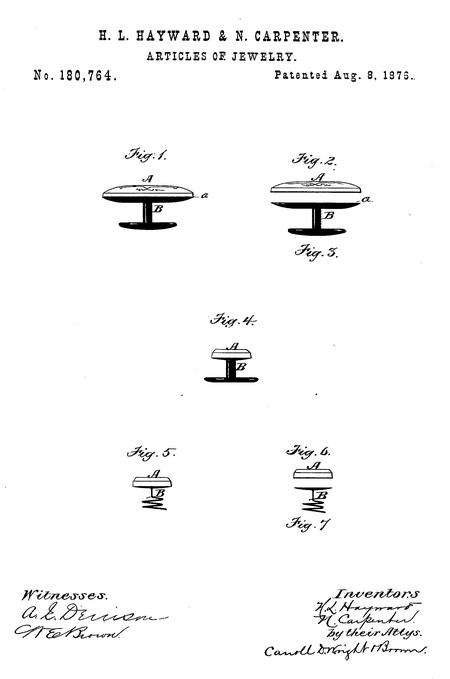Nelson Carpenter
- Born: 2 Jan 1836, Attleboro MA
General notes:
Jeweler
Events in his life were:
- He appeared on the census in 1855 in Attleboro MA. Listed as a jeweler.
- He worked circa 1858-1875 as a jeweler in Attleboro MA
- He appeared on the census in 1860 in Attleboro MA. Listed as a jeweler.
- He appeared on the census in 1870 in Attleboro MA. Listed as a manufacturer.
- Partnership: E. A. Bliss, in 1875-1883, in Attleboro MA. As CARPENTER & BLISS.

- He was issued patent number 180,764 on 8 Aug 1876
HENRY L. HAYWARD AND NELSON CARPENTER, OF ATTLEBOROUGH, MASS. IMPROVEMENT IN ARTICLES OF JEWELRY.
Specification forming part of Letters Patent No. 180,764, dated August 8, 1876; application filed May20, 1876.
To all whom it may concern:
Be it known that we, Henry L. Hayward and Nelson Carpenter, of Attleborough, in the county of Bristol and State of Massachusetts, have invented certain Improvements in Articles of Jewelry, of which the following is a specification:
In the accompanying drawing, forming a part of this specification, Figure 1 represents a view of a sleeve-button constructed in accordance with our invention. Figs. 2 and 3 represent views of the parts disconnected; and Figs. 4, 5, 6, and 7 represent other articles of jewelry and parts thereof.
Similar letters of reference in the several figures refer to like parts.
This invention relates to that class of articles in which certain portions of the article when in use come in contact with the skin or garments of the wearer, such as sleeve, collar, and cuff buttons, shirt-studs, &c. As only the outer surfaces or fronts of this class of articles are visible when in use, it is not strictly necessary in order to produce a rich appearance, that any part other the front or exposed surface be made of gold or other comparatively-precious material, At the same time the portions of the article which touch the skin or linen, if made of metal, are very liable to soil or disfigure anything with which they come in contact.
Our invention has for its object the production, at a moderate cost, of very desirable articles, which shall combine the beauty and richness of gold jewelry with the otherwise desirable qualities of japanned jewelry, which has for years been made, and as is well known will not disfigure the skin or garments of the wearer, and having a smooth glassy surface will not wear out the button-holes like other jewelry.
To these ends our invention consists in the combination of a front of gold or other comparatively precious or desirable material with a body having a stud or other fastening, the result being an article which is at once handsome, durable, inexpensive, and entirely satisfactory to the wearer.
In carrying out our invention we construct a sleeve-button or other like article in two parts, viz: a front piece, A, of any suitable
form and design, composed of gold, gold-plate, or other comparatively-precious material, and a japanned base or body, B. The japanned body is of the general form of the article to be made, and is the part which comes in contact with, and is attached to, the garment of the wearer. We connect the two parts rigidly together in any suitable manner, solder being the preferred means.
When solder is used it is applied between the inner surface of the thin metal face A and the coinciding face of the plate a of the base, not only securely connecting the two, but imparting a solidity, stiffness, and strength that permit the use of an extremely thin face-plate, and thereby greatly reduces the cost of the article.
Care should be taken, however, in soldering the parts together, not to heat the japanned base too highly, as the japan would be injured and rendered less durable by being subjected to the degree of heat at which ordinary lead-solder fuses. To avoid this, we employ solder composed of an alloy which is fusible at a degree of heat which the japan will readily withstand, this process of uniting the parts insuring the durability of the japan, and thus greatly increasing the usefulness of the completed article.
The parts are, preferably, so formed that when united the body will be invisible when the article is viewed from the front, and vice versa.
By this combination we obviate the necessity of using precious metals for any part of a sleeve-button or other like article, excepting the front, and thus produce a handsome ornament at moderate cost, which combines all the desirable features of both gold and japan.
It will be seen by reference to the drawing that the invention is applicable to spiral-wire shirt-studs, as well as to ordinary studs or buttons made with a shank and a foot.
We are aware that articles of jewelry have been heretofore made of two parts, the rear portion being of base metal, and that articles of jewelry of the same material throughout have been partially enameled or coated to prevent them from discoloring the clothing; but we are not aware that any one prior to ourselves has ever made articles of two parts, coated the base portion with japan, (which is cheap, protects the clothing, and prevents the exposure of the base metal,) and then united the two finished portions.
We claimó
As a new article of manufacture, an improved button or stud, composed of a face, A, of precious metal, and a stud and back, B, of base metal coated externally with japan, and united to the face by means of fusible solder, substantially as set forth.
In testimony whereof we have signed our names to this specification in the presence of two subscribing witnesses.
Henry L. Hayward
Nelson Carpenter
Witnesses:
Virgil H. Capron
Sumner S. Streeter
- He appeared on the census in 1880 in Attleboro MA. Listed as a manufacturing jeweler.
|

